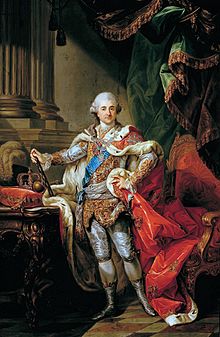Stanisław II
| Stanisław II Augustus | |
|---|---|

Stanisław II August in coronation robes,
by Marcello Bacciarelli |
|
|
King of Poland Grand Duke of Lithuania |
|
| Reign | 7 September 1764 – 25 November 1795 |
| Coronation | 25 November 1764 St. John's Archcathedral, Warsaw |
| Predecessor | Augustus III |
| Successor | Partitions of Poland |
| Born |
17 January 1732 Wołczyn, Polish–Lithuanian Commonwealth |
| Died | 12 February 1798 (aged 66) Saint Petersburg, Russia |
| Burial | St. John's Archcathedral (Warsaw) |
| Issue Details... |
illegitimate |
| House | Poniatowski |
| Father | Stanisław Poniatowski |
| Mother | Konstancja née Czartoryska |
| Religion | Roman Catholicism |
| Signature | |
Stanisław II Augustus (also Stanisław August Poniatowski; born Stanisław Antoni Poniatowski; 17 January 1732 – 12 February 1798) was the last King of Poland, Grand Duke of Lithuania and the last monarch of the united Polish–Lithuanian Commonwealth (1764–95). He remains a controversial figure in Polish history. Recognized as a great patron of the arts and sciences and an initiator and firm supporter of progressive reforms, he is also remembered as the last king of the Commonwealth whose election was marred by Russian involvement. He is criticized primarily for his failure to stand against the partitions, and thus to prevent the destruction of Poland.
Arriving at the Russian imperial court in Saint Petersburg in 1755, he became romantically involved with the twenty-six-year-old Yekaterina Alekseyevna (the future Empress Catherine the Great, reigned 1762–1796). With her support, in 1764 he was elected king of Poland. Against expectations, he attempted to reform and strengthen the ailing Commonwealth. His efforts met with external opposition from Prussia, Russia and Austria, all interested in keeping the Commonwealth weak; and from internal conservative interests, which saw reforms as threatening their traditional liberties and prerogatives.
The defining crisis of his early reign, the War of the Bar Confederation (1768–1772), led to the First Partition of Poland (1772). The latter part of his reign saw reforms wrought by the Great Sejm (1788–1792) and the Constitution of 3 May 1791. These reforms were overthrown by the 1792 Targowica Confederation and by the War in Defense of the Constitution, leading directly to the Second Partition of Poland (1793), the Kościuszko Uprising (1794) and the final Third Partition of Poland (1795), marking the end of the Commonwealth. Stripped of all meaningful power, Poniatowski abdicated in November 1795 and spent the last years of his life in semi-captivity in Saint Petersburg.
...
Wikipedia
